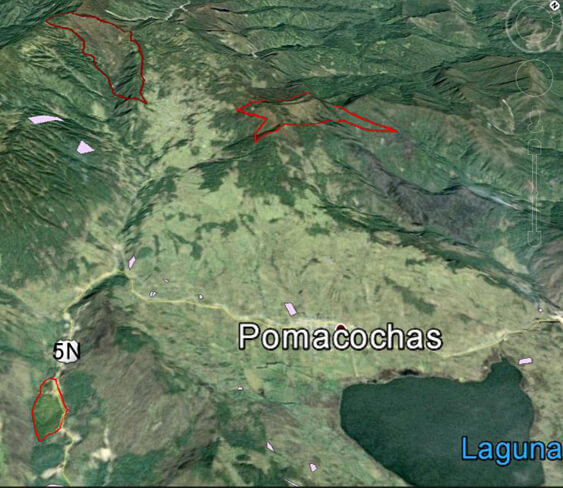Complementary Actions Protect Both Rare Birds and Water Resources in Northern Peru
 |
| The Little Woodstar is one of the species benefiting from actions in Peru to expand a key bird reserve and protect cloud forest areas. Photo by Daniel J. Lebbin. Photo may be used with credit. |
(Washington, D.C., April 30, 2013) Four communities in Peru have agreed on complementary land actions that will protect 930 acres of vital cloud forest and double the size of an increasingly popular bird reserve – generating benefits for all.
In one action, the communities of Miraflores, Chido, and San Lorenzo in northern Peru have formally agreed to protect 930 acres of vital cloud forest and headwaters of the Rio Chido, which provide water to these communities and the larger community of San Lucas de Pomacochas downstream.
In return for helping to protect its water supply, the community of Pomacochas has agreed to extend the 96-acre Marvelous Spatuletail Ecological Easement (also known as the Huembo Reserve) by an additional 89 acres, nearly doubling the popular reserve's size.
These conservation actions were facilitated by Asociación Ecosistemas Andinos (ECOAN), the local Peruvian conservation organization that has worked closely with American Bird Conservancy (ABC) to achieve significant advances in bird conservation in the country.
“This is a truly innovative project that benefits multiple communities by securing their rights to land and water resources,” said Tino Aucca, President of ECOAN.
By protecting their forests and watershed, the communities help secure their land rights, which are threatened by invading squatters as well as commercial interests in natural resource extraction. Likewise, securing water is important to the Pomacochas community downstream. Forests in this area have been rapidly cleared in recent years for pastures and agriculture.
“This is a two-for-one deal. By doing the work to protect the Rio Chido watershed, we also get more land protected at Huembo downstream. It's a real bargain for conservation and perhaps for the local economy as the reserve continues to generate tourism interest,” remarked Dr. Daniel Lebbin, Conservation Biologist at ABC.
The communities have formally submitted applications to the Peruvian agency in charge of protected areas to recognize the 930 acres under two Private Conservation Areas (PCA) – a legal type of protected area incorporated into the Peruvian national system of protected areas. While the Peruvian government evaluates these proposals, the communities have begun protecting these forests and erected signs to announce this policy change.
The forests of the Rio Chido watershed support several threatened and endemic bird species, including the Russet-mantled Softtail, Pale-billed Antpitta, Rusty-tinged Antpitta, Johnson's Tody-Tyrant, and Rufous-browed Hemispingus. For this reason the Rio Chido area has long been popular with intrepid bird watchers willing to explore the remaining forests. Meanwhile, the drier and lower forests of the expanded easement at Huembo support two threatened hummingbird species: the Marvelous Spatuletail and Little Woodstar.
 GoogleEarth image shows downstream relationship of Huembo Reserve (outlined in red in the lower center of the image)to the upstream, proposed San Lorenzo PCA and proposed Arroyo Negro PCA (outlined in red near the top of the image). |
These newly protected community lands are just part of the recent success achieved in northern Peru by ECOAN and ABC. Previously in 2013, ABC and ECOAN purchased three properties spanning 412 acres to secure former private lands to expand the Abra Patricia Reserve (formally known as the Abra Patricia-Alto Nieva Private Conservation Area). The area is recognized by the Alliance for Zero Extinction as a critical site for both the endangered Long-whiskered Owlet and endangered Ochre-fronted Antpitta.
Reforestation work continues in the area as well, with 89,000 trees and coffee bushes planted or scheduled for planting during April 2013 in communities surrounding the Huembo and Abra Patricia reserves, involving the communities of San Lorenzo, Chido, and Pomacochas. ABC and ECOAN also completed a tree nursery with the capacity to produce 13,000 saplings annually at the community of La Union, just north of the Abra Patricia Reserve.
Birdwatchers interested in visiting the San Lorenzo area can do so while staying at Huembo or Abra Patricia, and can consult Conservation Birding for more information on lodging at these sites.
Support for the land protection, land acquisition, community programs, and reforestation efforts was provided by the U.S. Fish & Wildlife Service under the Neotropical Migratory Bird Conservation Act, New England BioLabs Foundation, DJ & T Foundation, Patricia & David Davidson, Jeff & Connie Woodman, the Robert W. Wilson Charitable Trust, David Harrison and Joyce Millen, Warren & Cathy Cooke, Mike and Lorna Anderberg, Jeniam Foundation, The Mohamed bin Zayed Species Conservation Fund, and the IUCN NL / Small Grants for the Purchase of Nature (SPN), sponsored by the Netherlands Postcode Lottery.


















































